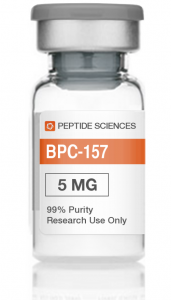 Entadecapeptide BPC 157, which is comprised of 15 different amino acids, is a partial sequence of BPC, or Body Protection Compound. BPC 157 is found in human gastric juice. It is isolated and extracted to be used for several purposes. Experiments have shown that it has the potential to accelerate the healing process, in particular tendon injuries. It showed promising results with transected rat Achilles tendons.
Entadecapeptide BPC 157, which is comprised of 15 different amino acids, is a partial sequence of BPC, or Body Protection Compound. BPC 157 is found in human gastric juice. It is isolated and extracted to be used for several purposes. Experiments have shown that it has the potential to accelerate the healing process, in particular tendon injuries. It showed promising results with transected rat Achilles tendons.
The study was performed in order to test the potential for BPC 157 to enhance the healing process for injured tendons. The outgrowth of tendon fibroblasts from tendon explants was examined, both with and without BPC 157 included in the culture. The results o the study showed that the sample with BPC 157 experienced significantly more outgrowth of tendon explants. The MTT assay concluded that the cell proliferation of culture tendon fibroblasts taken from rat Achilles tendons wasn’t directly affected by BPC 157. With that said, the survival of cells treated with BPC 157 was much higher under H202 stress.
A transwell filter migration assay showed that BPC 157 caused a marked improvement on in vitro migration of tendon fibroblasts, with the results affected by the size of the dose of BPC. BPC 157 was also shown to increase the spreading of tendon fibroblasts on the culture dishes.
FITC-phalloidin staining was used to find F-actin formations that were then added to the fibroblasts treated with BPC 157. Western blot analysis was used to determine the protein expression and activation of paxillin and FAK. The study showed that the phosphorylation levels of paxillin and FAK were both increased by BPC 157 without altering the total amount of protein. BPC 157 has been shown to promote the ex vivo outgrowth of tendon fibroblasts taken from tendon explants, helps with in vitro migration of tendon fibroblasts, and helped ensure cells survived under stress. This is likely made possible by the activation of the FAK-paxillin pathway.
Sport Injuries and BCP
Tendon injuries are among the most common sports injuries. The tendon is made up from cells – called tendon fibroblasts – and an extracellular matrix. This matrix is made up of type-1 collagen, type-3 collagen, and glycoproteins. Tendon injuries are generally caused by the tendon fibers tearing as a result of aging or overuse. Tendon injuries can occur suddenly or they can build up over time.
The damaged tendon may have trouble healing naturally. It is vital that the tendon be repaired as quickly as thoroughly as possible, often through surgery. The tendon healing process is split into three distinct, overlapping, stages; the inflammation stage, the regeneration stage, and the remodelling stage. During the regeneration stage, tendon fibroblasts enter the injured site, proliferate, and stimulate the production of glycoproteins and collagens to form an extracellular matrix.
